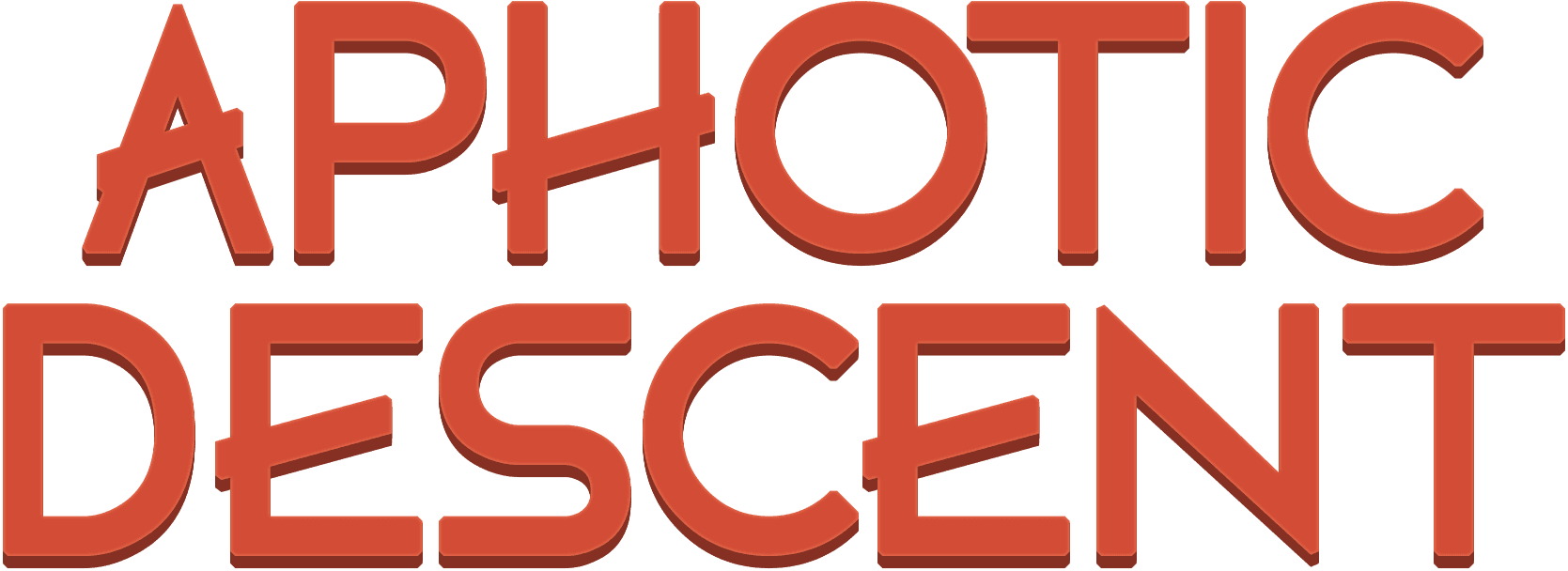
General Information
Game Summary
In Aphotic Descent, you play as a diver who has crashed their submarine at the bottom of the ocean. With no other option for survival, you must make your way to a nearby underwater research base while encountering terrifying creatures.
Explore immersive underwater environments and fight for your survival as you unravel the dark secrets of the research base and uncover the sinister experiments that were being conducted there.
Development Information
Team Size: 19
Project Duration: 32 weeks (September 2022 - May 2023)
Engine: Unity
Platform: PC
Store: Steam
Key Features
Explore the Depths
Descend into the ocean, where you’ll journey through various zones, from the sunlit surface zone to the twilight zone and finally the aphotic zone where monstrosities of the deep exist.
Prey vs Predator
Encounter a diverse range of creatures, where every encounter presents a unique challenge that requires you to adapt your skills and equipment in order to survive in tense environments.
Suit Up
Equipped with a powerful flashlight and your trusty diving knife, you’ll illuminate the dark waters around you, while using the blacklight feature to reveal hidden clues and solve puzzles, and defend yourself against aggressive predators and destroy key objects to complete encounters.



Project Role & Responsibilities
Main Role: Producer
Secondary Role: UI Designer
Lead and managed workflow for a team of 19 game developers to deliver a high-quality game project on schedule.
Facilitated daily scrums and managed nine 3-week sprints for a cross-functional team to ensure project goals and deadlines were met.
Built a team structure by appointing leads to clarify responsibilities and spread the management workload.
Contributed to designing UI/UX elements that are used to navigate thoughtful and engaging puzzles.
Managed formal documentation, project schedules, and milestones, including creating and maintaining design documents.
Set up effective remote and in person communication methods for the team throughout the project's course and created a team contract.
Performed regular 1-on-1 meetings with members of the team to ensure personal issues/concerns were identified.
Worked with the original vision holder to ensure documents were aligned with the team's creations.









Phases and Process
Original Pitch Video
Aphotic Descent
Cinematic Trailer

Shrimpman Concept Art
By: Sarah Rootsey (Art Lead)

Discipline Pipelines

Sprint 4 In-Game Screenshot

Sprint 2 QA Analysis Sheet
As the project started up I wanted to ensure that the team would have an easy and effective way to communicate with each other remotely, so we used a Discord server when working from home. Tuesdays and Thursdays we held in person standup meetings, while Mondays, Wednesdays, and Fridays standups were online.
Since I wasn't the original vision holder, I worked closely with them to ensure that our initial concept was shaped to what they envisioned for the project, while also keeping scope in the forefront. The vision holder and 3 other team members created a powerpoint presentation of original concept art of characters, enemies, locations, and mechanics, which also included a rough pass of the original game story, and some moodboards.
We used an Agile project structure for the project's entirety to help us iterate and adjust ideas, so I set up ClickUp, which would allow us to have a sprint based structure. This would allow the leads, creative director, and myself the ability to assign tasks, keep track of progress of the project based on each sprints progression, and for the team to be able to reflect and iterate on each sprints progress as a team.
As the producer I also created a High-Level Planning document, which would be the foundation for each sprint, identifying key deliverables, and being able to adjust the overall plan where possible if we started to get out of scope or encountered unaccounted setbacks. Along with the H.L.P document, I created a Risk Log and S.W.O.T analysis to help with potential issues and opportunities.
Concept Phase
Pre-Production Phase
Once we moved into Pre-production, each discipline lead created a flowchart of their pipeline from ideation to implementation, which allowed each member to speed up workflow for each aspect of the project. Making sure these pipelines were followed closely was vital to the project's success.
Also during the Pre-production phase I assigned our QA Lead and helped him set up documentation that can be used for bug fixing and QA for the entirety of the project's duration. Team members from all disciplines would perform QA, but we also had people from outside the project pitch in on weekly builds to report bugs and any other errors within the game.
During this part of the project, I also started to evaluate the project's overall scope. Due to some setbacks, we had to lower the project's scope a bit, but doing so allowed for us to focus more on key deliverables and spend more time on polishing different aspects of the game.
Production Phase
Once we started transitioning from pre-production, we had established our main mechanics for puzzle solving and movement based areas, along with some other proof of concepts for enemy encounters done, but we had plenty of other aspects of the game that needed to be revised.
After the first sprint, we started refining some of our narrative so that our levels would fit with the storyline and make for a compelling story for the player. While working on the narrative we also refined some of the original mechanics to fit more with the new level designs so that they would feel challenging, but rewarding to use for the player.
Throughout the next nine sprints, the teams would continue to develop the game until its publication on Steam, and I would continually schedule 1-on-1 talks with them to discuss any issues that they had and I managed to resolve their issues and improve the teams overall productivity. Throughout these sprints I also kept a close eye on the team members' velocity and the risks that we determined at the end of each sprint to ensure we wouldn’t run into any issues later down the road.
One of the first challenges on this project was that I had to teach the team members how to properly use the production tools and methods, so towards the beginning of the project it took quite some time to get them all used to using them daily and realizing just how important it is to the project's success. After repetition the team understood the value of these documents and tools and embraced them throughout the rest of the project.
A huge challenge with this project was scope creep, as we started with the very ambitious concept that I ended up having to cut down on multiple times to make sure that the project was feasible to complete by the deadline. Most of the scope creep was towards the programming of enemy encounters, as we didn’t have as many programmers as we did artists, so we had to make sure that what the programmers worked on was of the utmost importance for the games success.
Challenges Encountered

Production Documents

For our project I used a document that takes data from ClickUp and allow me to import it into an Excel sheet to see individual members velocity. This allowed me to keep track of productivity and blockages for all of the sprints. To see the entire document Click Here.

Throughout the project I maintained a Risk Log for all nine sprints. The risk log helped us identify potential risks for the sprint and assisted the leads in determining what tasks would be more important to get done in order for the project to succeed. To view the entire risk log Click Here.

The High Level GANTT chart was created using ClickUp and then later was exported for review by the leads. This has helped us indentify any immediate problems or bottlenecks and find a solution for them. To view the entire projects exported document Click Here.
Velocity
Tracking Document
Risk Log
High Level
GANTT Chart


